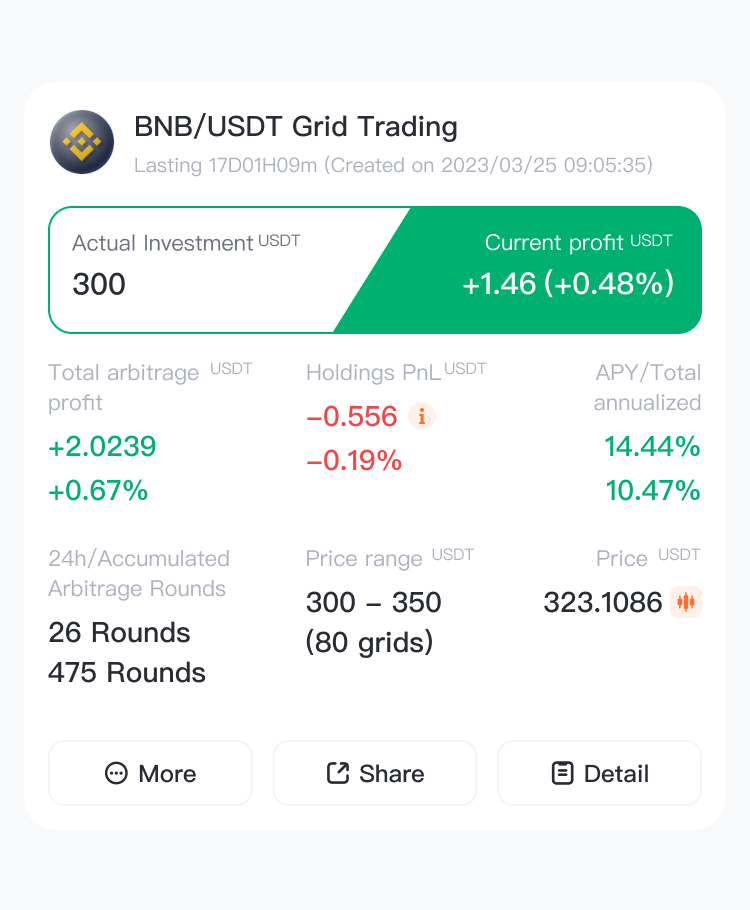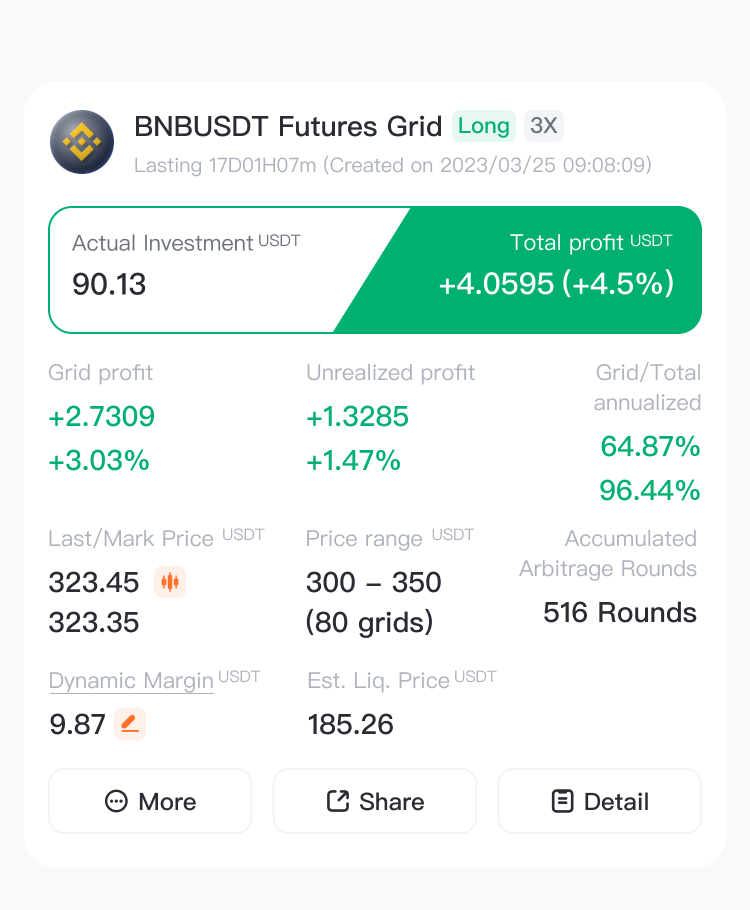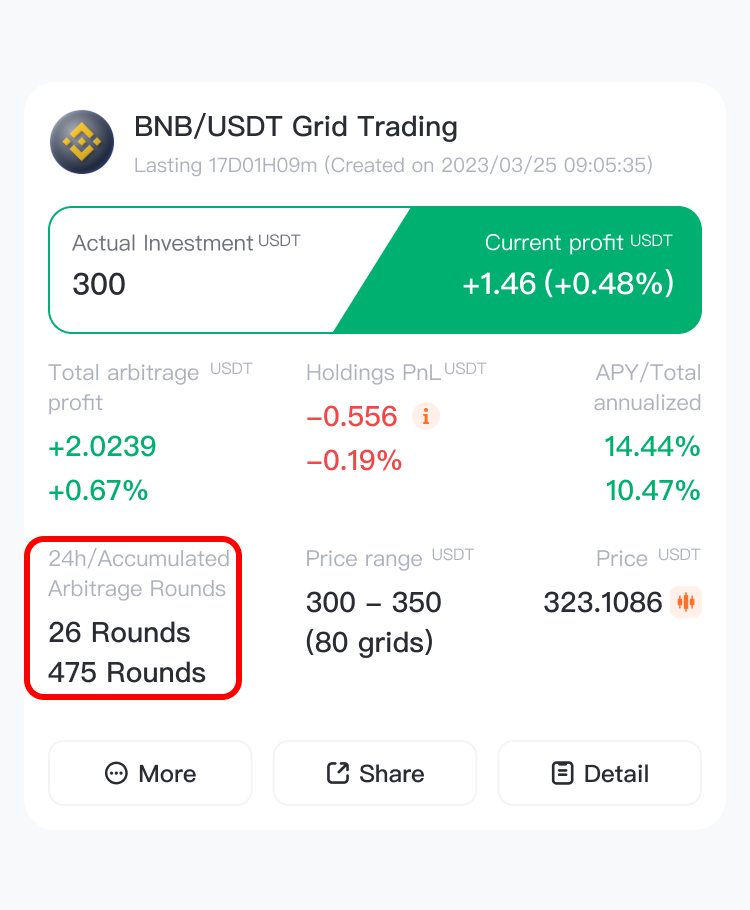As Pionex introduces futures trading, there is a growing curiosity about when it will introduce futures trading bots. Among all the trading bots available, the grid trading bot holds the highest expectations.
On March 25, 2023, I got access to the early beta version and created several Pionex futures grid bots for testing. After the test, I discovered that the Pionex futures grid had many advantages over the spot grid.
Pionex futures grid trading is now officially available. Android users can download the latest APK from the official website Pionex | Bitcoin Ethereum Auto buy low and sell high | Free Crypto Trading Bot or update it from Google Play. iOS users can update through TestFlight. And it will also be available on the App Store in the future.
Contents
Test Results
Let’s take a look at the test results. The following three screenshots show the spot grid for BNB/USDT, the futures grid with 1x leverage, and the futures grid with 3x leverage. It is clear that with the same parameters and running time, the futures grid with 1x leverage yields more than the spot grid, while the futures grid with 3x leverage profits three times more than that of the spot grid trading.






Why does Pionex’s futures grid have such a significant advantage in terms of profitability with the same parameters? It can be said that it loses less than the spot grid when facing losses and earns more than the spot grid when making profits. Let’s dive deeper into the details.
The three main advantages of the Pionex Futures Grid
Pionex futures grid trading outperforms spot grid trading in terms of returns due to three key factors: funding rates, trading fees, and volatility.
Funding Rates
Perp Futures have a funding rate mechanism, which can be either positive or negative. A positive funding rate allows you to earn additional funding if you have a short position. Conversely, a negative funding rate enables you to earn extra funding when you have a long position.
In my test, I used the BNBUSDT futures trading pair, which has a negative funding rate. This means that having a long position allows me to earn additional funding.


Although there is no historical funding rate data available in Pionex yet, based on my observation, the funding rate for BNBUSDT perpetual futures tends to remain negative in the long term. During profitable periods, you can earn an additional 0.2% profit per day for each leverage multiple, resulting in an annualized return of 70%+. This means that if you create a Pionex futures grid with a leverage of 10x, you can potentially earn over 700%+ annualized return compared to spot grid trading.
Coincidentally, spot grid trading itself follows a long position logically. Therefore, if you also set up a grid trading strategy and use the futures grid, you can earn additional funding fees. Moreover, when opening a long position with 1x leverage, the future will never be liquidated, aligning the risk with spot-leveraged trading. So, why not directly replace your spot grid with the Pionex futures grid?
Therefore, as long as a cryptocurrency with negative funding rates, opting for Pionex futures grid is a great choice compared to creating a spot grid. Moreover, for cryptocurrencies like BNB with lower volatility, maintaining a low leverage on Pionex futures grid over the long term is an excellent arbitrage strategy!
Trading Fees
Frequent grid traders are well aware that trading fees play a vital role and directly impact grid profits. Pionex is already one of the exchanges with the lowest transaction fees in the industry. The default Maker and Taker fees are only 0.05%, significantly lower than Coinbase’s 0.5%.
However, in futures trading, Pionex charges Maker 0.02% and Taker 0.05% as transaction fees. Since grid trading primarily involves Maker orders, the transaction fees for futures trading are effectively discounted by 60% compared to spot trading. This means that for every grid arbitrage, you would earn an additional 0.03% in profit. If your profit per grid is 0.1%, it is equivalent to an extra 30% in grid profits.


And Futures trading also has a corresponding VIP system, where the lowest transaction fees can be as low as 0%. With VIP2, fees can be reduced to 0.01%, equivalent to only 20% of the spot grid trading fees. It’s a highly cost-effective option!
Another tip here, you can also use a small amount of money to trade with 100x leverage and increase your trading volume to maintain VIP status. For instance, with just $500 and 100x leverage, you can generate a trading volume of $100,000 by closing your position whenever you’re not at a loss.


Volatility
Everyone knows that, as most users leverage their positions, the futures market tends to have higher liquidity than the spot market. Consequently, during market oscillations, the futures market typically exhibits greater volatility compared to the spot market. For grid trading, higher volatility leads to increased arbitrage opportunities and higher annualized returns.
How can we demonstrate that Pionex’s futures market exhibits greater volatility than the spot market? Let’s directly examine the data:




From the bots above, it is clear that during a 17-day period, the spot grid trading strategy generated a total of 475 transactions, averaging 27.94 per day. While the Pionex futures grid trading strategy produced a total of 517 transactions, averaging 30.41 per day, which is 8.84% higher. This indicates that your grid trading profits can be increased by nearly 10%!
Are you feeling excited and eager to create a Pionex futures grid? Let’s dive into how to set it up together!
How to create a Pionex Futures Grid?
If you have already upgraded to the latest version as described at the top of the article, you can start using Pionex’s futures grid.
Steps: Click “Trade” > “Create the bot” > “Futures Grid”


The default selection for Pionex futures grid trading is ETHUSDT perpetual. Just like spot grid trading, Pionex offers various copy-trading strategies, including conservative, balanced, and aggressive options. Let’s take the example of longing the BNBUSDT perpetual:
You can freely choose a strategy, and upon selection, it will provide you with the estimated liquidation price. The “estimated liquidation price” refers to the price at which your grid will be forcefully liquidated, resulting in the automatic closure of orders and the loss of your entire investment amount.




If you’re not satisfied with the default strategy, you can also choose to set parameters manually.
One parameter that is different from spot grid trading is the “Reserved Margin.” So, what is “Reserved Margin”? This brings us to the advantages of Pionex’s futures grid compared to other exchanges’ futures grids.
Pionex Futures Grid Advantage: Two-Layer Buffer Technology and Dynamic Order Placement Technology
As a leading platform in the trading bot industry, Pionex is committed to providing the best trading bot experience. In the development of Pionex Futures Grid, we have once again taken the lead in various details.
Many users often encounter confusing issues when using futures grids on other exchanges. On OKX, the calculated liquidation price can sometimes be inaccurate.
To address these issues, Pionex has implemented Two-Layer Buffer Technology and Dynamic Order Placement in its futures grid trading. These advanced techniques aim to ensure the stable operation of the Pionex futures grid and accurately calculate the estimated liquidation price before reaching the point of forced liquidation.
What is Two-Layer Buffer Technology? In futures trading, due to the requirement of maintaining margin, unfilled orders that are close to liquidation are often automatically canceled. In this situation, some exchanges close the grid trading and liquidate the positions automatically. However, such an approach can lead to unnecessary losses for users, especially when the market quickly rebounds after a temporary downturn. In contrast, Pionex’s approach is different. When faced with this situation, Pionex does not close users’ orders. Instead, it automatically restores the maximum number of pending orders based on the user’s current position and margin. Furthermore, it allows users to add margin and automatically place more orders once the margin is supplemented.
Thanks to the two-layer buffer technology, Pionex’s futures grid supports leverage of up to 100x, and users can freely set parameters such as intervals and grid numbers without considering the correlation between parameters, greatly enhancing the user experience.
Furthermore, to achieve the two-layer buffer technology, Pionex adopts the same dynamic order placement technology as in spot grid trading, automatically placing orders near the current price, maximizing the utilization of user margins.
Setting Parameters for Pionex Futures Grid
After talking about the technical advantages of Pionex, let’s go back to the “Reserved Margin” parameter. In order to ensure that your futures grid will not be forced to close within the price range and that you will be able to place all your orders even if you reach the upper/lower limit of the range, we recommend that you
reserve an adequate amount of margin by default.
Of course, you can choose not to select this option when opening an order to maximize your fund utilization. However, the risk involved is that you may face forced liquidation within the grid range or enter the two-layer buffer state. In this case, some of the grid cells you have set may be unable to place orders until you add sufficient margin again.
Your fund distribution will be displayed before placing the order. Once you confirm the parameters, you can start the Pionex futures grid trading.




After placing the order, you can also withdraw the unused dynamic margin at any time. You can click on “More”, and then add or withdraw the margin.




Other parameters and order details of the Pionex futures grid are similar to the spot grid and will not be further elaborated here.
Subsequent updates on the Pionex Futures Grid
Pionex will add more advanced settings and features to the futures grid, such as adding and suspending positions, which are already available on the spot grid, as well as some new and innovative features. Stay tuned!
Community
If you have more questions, you can enter our Telegram group for communication:https://t.me/pionexen
FAQ
1. What is the difference between the Pionex Futures Grid and the Pionex Spot Grid?
The Pionex Futures Grid is based on futures trading. In addition to the normal grid trading functions, it allows for leverage of up to 100x and enables short selling. Its principles are consistent with those of regular spot grid trading.
2. Does Pionex Futures Grid use funds from my Futures Account?
The funds used in the Pionex futures grid and other futures bots are sourced from your primary account, so the funds in your futures account will not be used, which reduces unnecessary operations such as transfers.
3. What is the Dynamic Margin? Can I withdraw it?
As mentioned in the article, the dynamic margin is designed to enhance the stability of Pionex Futures Grid Trading, ensuring that your grid remains within the specified range and reducing the chances of entering the two-layer buffer state. You have the option to disable the “Reserved Margin” feature before placing an order or withdraw the dynamic margin after opening a position to increase capital utilization.。